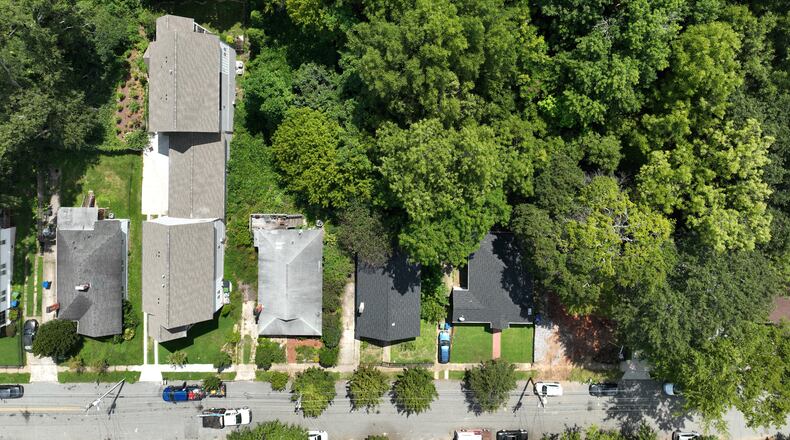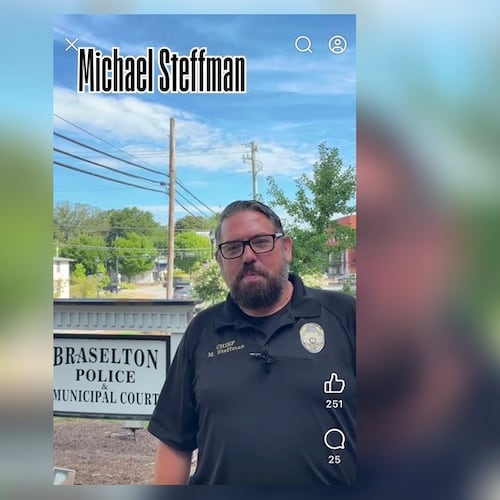An Atlanta City Council committee put off a vote on changes to the city’s tree protection rules Tuesday, after members chafed at getting a new and less stringent version of the complex legislation with little time to review it.
At the same meeting, the city’s planning department revealed it is proposing a “simplified” draft that removes — at least for now — tree preservation standards environmentalists had pushed for but builders had argued would squelch development.
The latest drama around Atlanta’s nearly 25-year-old tree ordinance came toward the end of a three-hour meeting of the council’s Community Development and Human Services Committee.
Credit: HYOSUB SHIN / AJC
Credit: HYOSUB SHIN / AJC
Tuesday’s hearing drew dozens, forcing the fire department to direct some attendees to watch the meeting on TVs outside the committee room for safety reasons.
Many in attendance wore green, a show of support for strengthening the tree ordinance — the city’s rules for removing and replacing trees.
The Atlanta Journal-Constitution has not yet viewed a copy of the city’s latest proposal, which several city council members said they had received less than 24 hours before the meeting.
But on Tuesday, City Planning Commissioner Jahnee Prince told the committee her department now feels like it needs to “test” key parts of the new ordinance alongside the city’s new zoning rules, which are also in development.
Prince indicated the city still wants to move forward with increasing its tree removal fees, known as recompense, plus offering assistance to low-income seniors to prune or remove dangerous trees, along with other measures.
Several council members, however, said they’d not had enough time to review the new proposal. Councilmember Liliana Bakhtiari was among those who expressed frustration about receiving the changes at the last minute.
“I will not be voting,” Bakhtiari said. “I’ll be motioning to hold because I don’t know what I’m being asked to vote on.”
Credit: Miguel Martinez
Credit: Miguel Martinez
Committee members voted unanimously to hold the measure until a later meeting, likely no earlier than May 27.
Provisions such as tree preservation standards for single-family residential and commercial lots contained in an early May draft of the tree ordinance rewrite drew fierce pushback from developers.
On Tuesday, such opposition included representatives from Habitat for Humanity, who said the changes would handicap their efforts to build affordable housing. Andrew Gurvey, an attorney and the director of real estate for Habitat for Humanity, called the city’s earlier draft with the preservation standards “an abomination.”
“This TPO (tree protection ordinance), if passed, is essentially going to push and halt all of our development out of the city until something can be fixed,” Gurvey said.
Atlanta’s current tree ordinance was enacted in 2001. And while the City Council has approved modest updates since then, past efforts at a total revamp have been bogged down by competing interests of builders and environmentalists.
But data shows the “City in the Forest’s” tree canopy has been shrinking for years.
The city has adopted a goal of 50% coverage, but in 2018, a survey by Georgia Tech senior research scientist Tony Giarrusso found coverage stood at 46.5%. A new canopy assessment could be released soon, and many expect it will show coverage is now below 45%.
As human-caused climate change leads to more intense heat waves, studies show trees offer a layer of public health protection. A 2023 study commissioned by Bakhtiari and Councilmember Matt Westmoreland found Atlanta’s most forested neighborhoods are dramatically cooler on hot days than those with few trees.
Rising temperatures are also linked to wetter storms and a heightened risk of flooding. Forested and other vegetated areas help absorb stormwater runoff from concrete streets and buildings.
Credit: JOHN SPINK / AJC
Credit: JOHN SPINK / AJC
At the same time, housing availability and affordability are significant problems in metro Atlanta. The city of Atlanta has adopted a goal of building or preserving 20,000 affordable housing units by 2030. Multifamily developments in certain neighborhoods are also required to set aside a percentage of their units as affordable housing.
The draft ordinance floated earlier in May offered reduced tree removal fees for affordable housing depending on the area’s median income. Developers would have also been able to trim their recompense obligations by replanting trees themselves.
Still, many builders said the proposals could imperil the city’s affordable housing goals.
Judy Yi, the director of marketing and outreach at Trees Atlanta — a nonprofit that works to protect and improve the city’s trees — argued developers were presenting a false choice and that tree protection and affordable housing could coexist with a stronger ordinance.
“I don’t know a community that can succeed without both,” Yi said.
A note of disclosure
This coverage is supported by a partnership with Green South Foundation and Journalism Funding Partners. You can learn more and support our climate reporting by donating at AJC.com/donate/climate.
About the Author
Keep Reading
The Latest
Featured





